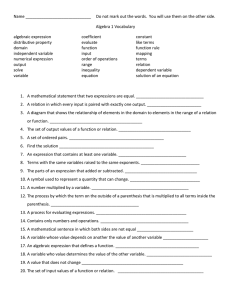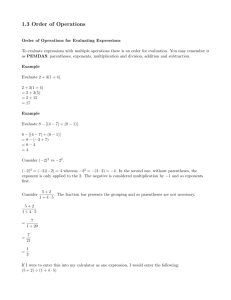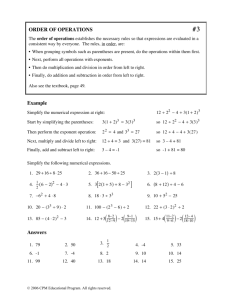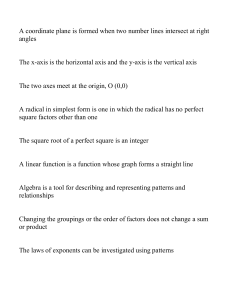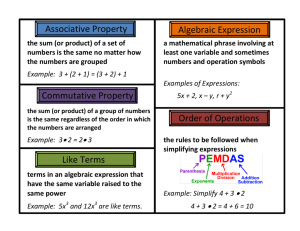Math 35 Introduction
advertisement
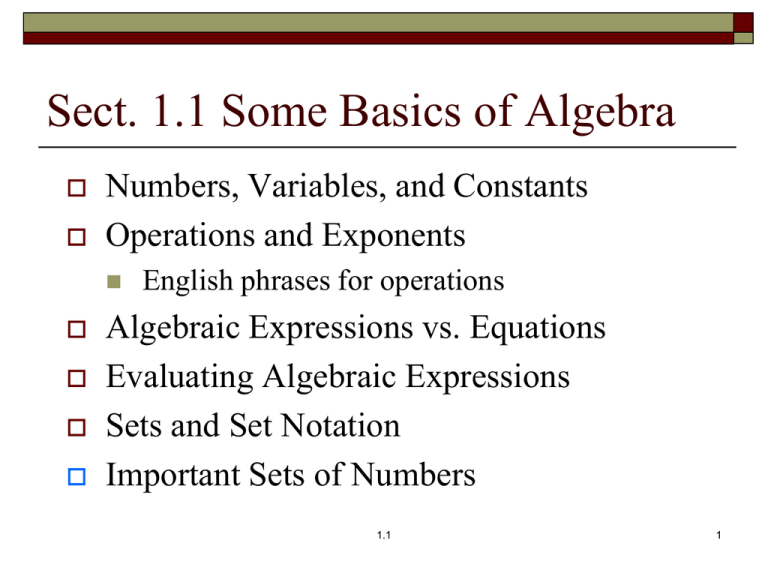
Sect. 1.1 Some Basics of Algebra
Numbers, Variables, and Constants
Operations and Exponents
English phrases for operations
Algebraic Expressions vs. Equations
Evaluating Algebraic Expressions
Sets and Set Notation
Important Sets of Numbers
1.1
1
Numbers, Variables, and Constants
Numbers: 127, 4.39, 0, -11¾, square root of 3
Integers, Decimals, Fractions, Mixed Numbers
Variables: x, a, b, y, Q, B2 etc
Constants: π, e, C=speed of light in vacuum
1.1
2
Operations and Exponents
Operations combine two numbers
Addition
Subtraction
Multiplication
Division
Exponents
3 + 6.2
⅔–5
356 · 0.03 or 356(0.03)
19 / 3 or 19 ÷ 3
74
1.1
Short for 7·7·7·7
3
Class Exercise: Op’s + – •
6 + 4 + 3 + 7 + 9 + 1 = 30
9 + 2 + 1 + 3 + 8 = 23
(-6) + (-2) + (-5) = -13
-6 – 2 – 5 = -13
8 + (-2) + (-9) + 6 + (-4) = 14 + (-15) = -1
6 • 2 • 5 = 60
-3 • 7 • (-2) = 42
2 • (-5) • (-3) • (-4) = -120
1.1
4
Class Exercise: Op ÷, fractions
4 3
7
13 13
13
1
3 5
4
10 6
4 2 1 4 6 2 10 1 5
5 3 6 5 6 3 10 6 5
24 20 5
1
lcd 30
30
30
3 5 3 2 3
8 2 8 5 20
1.1
5
Algebraic Expressions vs. Equations
Algebraic expressions have one or more terms
Sometimes expressions can be simplified
If each variable is replaced with a number, we can evaluate an
expression (reduce it to a single number)
Today we will review how to evaluate expressions
Tomorrow we’ll look at equations
An equation is two expressions separated by an equal sign – equations are
6
not evaluated, they are solved1.1
Evaluating Algebraic Expressions
Substitution is replacing a variable with a number
When every variable in an expression is substituted
with a number, we can evaluate that expression
Evaluate 3xz + y for x = 2, y = 5, and z = 7
3xz + y
(write original problem)
3(2)(7) + (5) (put parentheses for each variable)
(insert the corresponding numbers)
42 + 5
(simplify according to “order of operations”)
47
(final answer)
1.1
7
Class Exercise: mixed + • – ÷
3+2•6= ?
-3 – 3 = ?
-6 or 0
3 • 22 = ?
5 • 6 = 30 or
3 + 12 = 15
62 = 36 or
3 • 4 = 12
6+4÷2=?
10 ÷ 2 = 5
6+2=8
1.1
8
Rules for Order of Operations
To make sure an expression is always evaluated in
the same way by different people, the Order of
Operations convention was defined
Mnemonic: “Please Excuse My Dear Aunt Sally”
Parentheses
Exponents
Multiply/Divide
Add/Subtract
Always: Evaluate & Eliminate the innermost grouping first
1.1
9
Order of Ops Example
2 { 9 – 3 [ -2x – 4 ] }
2 { 9 + 6x + 12 }
2 { 6x + 21}
12x + 42
Remember: It’s an INSIDE job
1.1
10
Class Exercise – Evaluate expressions
7x + 3
7(5) + 3
35 + 3
38
3z – 2y
for x = 5
for y = 1 and z = 6
3(6) – 2(1)
18 – 2
16
[17 – (a – b)]
[17 – (-3 – 7)]
[17 – (-10)]
17 + 10
27
for a = -3 and b = 7
1.1
11
Sets and Set Notation
Finite sets and Infinite sets
Roster notation: {1, 2, 3, … } with ellipsis
Set-Builder notation: { x | x is an integer > 0}
Set of all real numbers:
Empty Set (no members):
Element of a set: 5 {1, 2, 3, 4, 5, 6}
Union of sets: {1, 2, 3}{3, 4, 5} = {1, 2, 3, 4, 5}
Intersection of sets: {1, 2, 3}{3, 4, 5} = { 3 }
Subset of a set: {1, 2, 3} {1, 2, 3, 4, 5}
1.1
12
Different Sets of Numbers
1.1
13
Next time:
1.2 Operations and Properties
of Real Numbers
1.1
14

